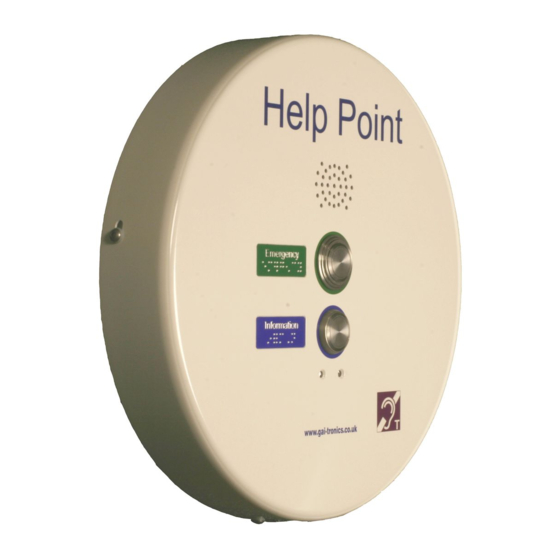GAI-Tronics PHP400 Руководство по установке и эксплуатации - Страница 7
Просмотреть онлайн или скачать pdf Руководство по установке и эксплуатации для Телефон экстренной связи GAI-Tronics PHP400. GAI-Tronics PHP400 20 страниц. Analogue version (1090/1099 series) with ampetronic hls-dm2 induction loop amplifier 230v ac power supply
Также для GAI-Tronics PHP400: Дизайн Установка и руководство пользователя (20 страниц), Руководство по установке и эксплуатации (20 страниц)

2. Ensure that a suitable SIM card is available (no SIM is supplied with the Help Point).
IMPORTANT: Ensure that the SIM is activated and not locked. If the SIM is locked
there is no way of unlocking it from the Help Point and the Help Point will not
function. It is also recommended to disable voicemail on the SIM.
3. Ensure that power is available: 230Vac @ 1A.
4. This is normally a two-person installation, due to the size/weight of the unit and due
to the need to connect cables between the 2 sections.
Opening the Unit
4.4.
To open the case, undo the 4 security screws around the edge of the unit. These
screws are normally Torx type with a centre security pin.
The front section is fitted over the rear section and can be gently lifted clear.
Take care when separating the 2 sections – there are 4 cable sets between the 2 halves:
1. Induction loop audio (2 conductors)
2. DC power (2 conductors)
3. Earth cable
4. Telephone cable.
These cables are deliberately short, but will allow the front section to sit to the left of the rear
for set-up purposes if required.
Installation method
4.5.
The Help Point is intended for vertical installation to a solid wall or suitable post as detailed
below.
1. Choose a suitable location for the Help Point, bearing in mind the weight of the unit,
and that the operating button(s) should normally be in the range 1200 – 1400mm
from the ground for ease of access by people in wheelchairs.
2. Mark the wall or surface with fixing centres as shown above. If necessary use the
rear section to help mark the centres. Do not use the rear section as a drilling
template.
3. Select fixing screws or bolts appropriate to the type of wall or surface, suitable to
support the unit. Drill fixing holes to suit.
4. Separate the front and rear sections of the Help Point, taking care to disconnect
interconnecting cables as described in section 4.4. Note that the protective edging
strip fitted to the rear edge of the front section may be removed if required. This strip
does not form any part of the water seal, and is primarily to provide protection to the
front section during installation (for example when laying it on the ground). The
edging strip may be refitted after installation or left off as required.
5. Secure the rear section to the wall, making sure that the fixing holes are sealed to
prevent water ingress using nylon washers or other appropriate sealing methods.
6. Bring the power cable into the unit through one of the cable entry holes. Cables will
normally be contained in conduit, but glands may also be used.
7. The power cable is terminated directly to the terminal block provided, and secured
using the cable restraint. Do not apply power until the SIM is fitted. If necessary
remove the fuse to disconnect power until the SIM has been fitted.
8. Ensure that all cable entries are sealed to prevent water ingress. The blanking plugs
fitted to unused cable entry positions must be left in place.
PHP400 GSM Help Point.
7
